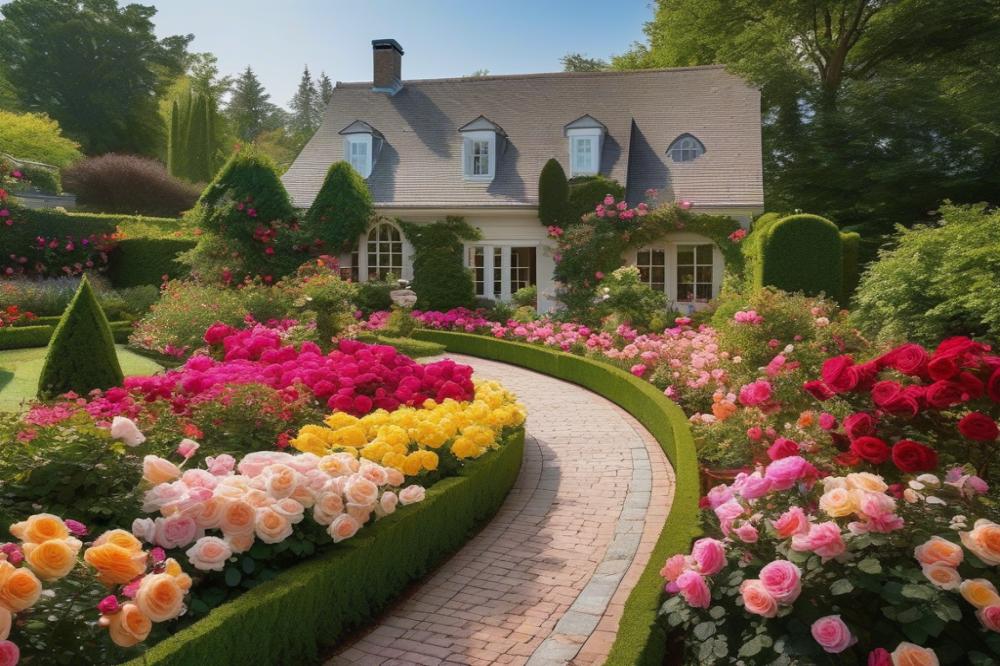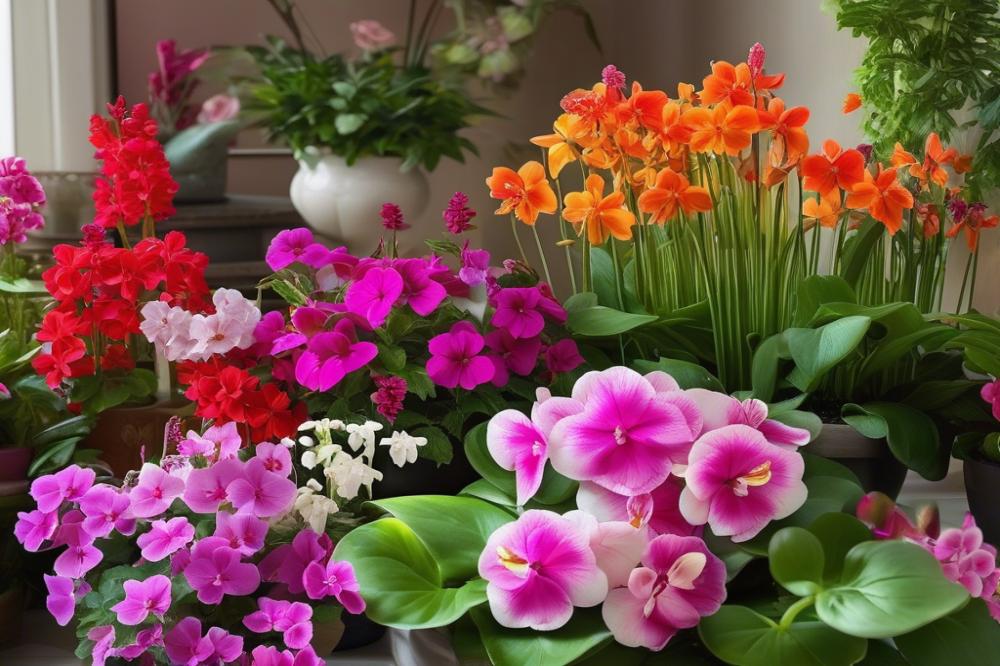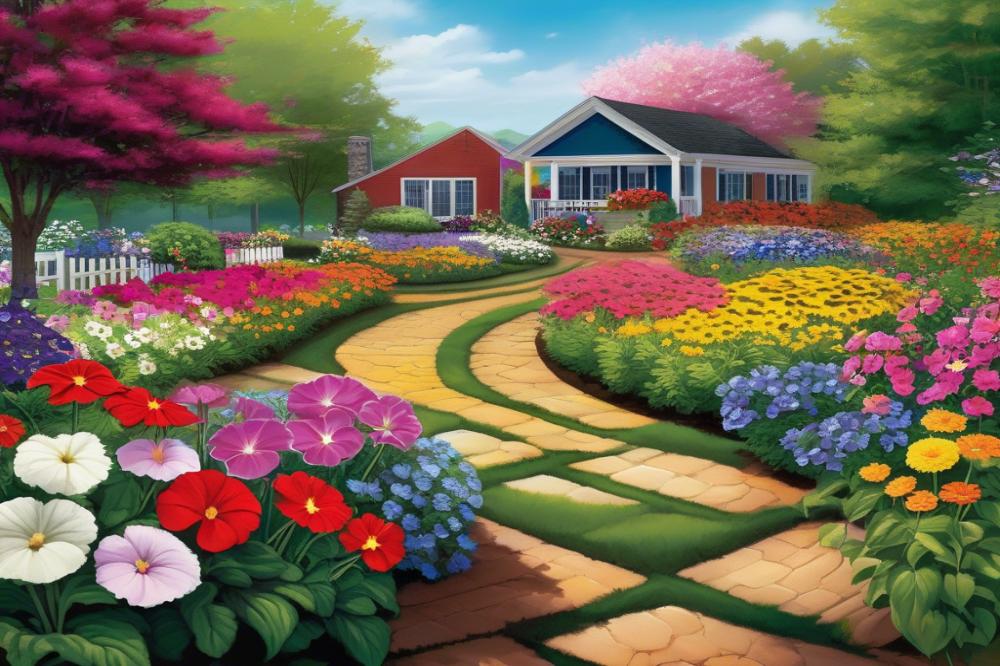Creating a Stunning Rose Garden
The way you arrange a rose garden can make all the difference. Thoughtful landscaping is key to showcasing the beauty of different rose varieties. An impactful design not only highlights the flowers but also influences the overall atmosphere of your outdoor space. A well-planned garden design can transform a simple area into a vibrant retreat.
A carefully crafted layout brings numerous benefits. First, it allows for better plant selection and encourages healthy growth. Different flower colors can be strategically placed for a stunning visual effect. Moreover, seasonal blooms can be scheduled to ensure there’s always something vibrant blooming. This leads to a delightful garden that changes with the seasons.
Additionally, effective garden planning can ease maintenance tasks. Proper placement of roses can facilitate easy watering and pruning. Consideration of companion planting adds layers of interest and functionality. With the right tips, maintaining a breathtaking rose garden becomes less overwhelming.
This article will provide a thorough overview of how to create a rose garden layout for maximum impact. You will discover layout ideas that enhance garden aesthetics and learn effective maintenance tips. From selecting the right rose varieties to planning blooms, this guide will support your journey toward achieving that perfect, beautiful space.
Understanding rose garden layout

A rose garden layout defines how you arrange your plants in a way that enhances beauty and functionality. Think of it as the blueprint for your floral masterpiece. Planning becomes vital when you want to display different rose varieties effectively.
When considering your design, landscaping plays a significant role. Elements like flower colors and textures should harmonize. This not only creates visual appeal but also sets the stage for seasonal blooms throughout the year. A well-thought-out layout can make your garden a stunning focal point in your outdoor space.
Next, it’s crucial to engage with plant selection. Choose roses that thrive in your climate. Consider their growth habits and sizes. Mixing different heights and shapes enriches the garden aesthetics. Companion planting adds another layer to this equation; certain plants boost each other’s growth and offer pest control.
Think of maintenance tips as essential advice for keeping your garden vibrant. Some varieties need more care than others. A layout that allows easy access for pruning and watering will save time and effort. Always plan with future growth in mind, as a crowded garden can quickly become unmanageable.
Don’t overlook the importance of garden planning. Sketching out layout ideas helps visualize the finished product. This can ease decision-making when selecting roses. Pay attention to sunlight and shade patterns throughout your garden space to maximize growth potential.
Ultimately, consider how you want the garden to feel. Whether you seek a vibrant, lively space or a tranquil retreat, the arrangement of flowers plays a critical role. Make your garden not just a space, but an experience that delights the senses and draws people in.
Choosing the Right Rose Varieties

Creating a stunning rose garden begins with selecting the right rose varieties. Popular options include hybrid teas, floribundas, and climbers. Each type offers something unique to garden aesthetics. Hybrid teas boast large blooms and long stems, making them perfect for cutting. Floribundas produce clusters of flowers, creating a vibrant display. Climbing roses can be trained on trellises or walls, adding height and drama.
When choosing rose varieties, consider several factors. Climate plays a significant role in plant selection. Different regions have various growing conditions. Be aware of the sun exposure in your garden. Roses thrive in full sunlight, so choose a location that gets plenty of light. Additionally, think about the size and space available for your layout ideas. Some varieties can grow quite large, while others remain compact.
Flower colors also influence your choice. Decide if you want a single-color theme or a mix of hues. Pink, red, yellow, and white roses can all fit beautifully together. Incorporating complementary colors enhances the overall impact of your garden. It’s crucial to consider seasonal blooms as well. Some varieties bloom once a season, while others produce flowers multiple times. Select roses that will provide continuous color and interest throughout the year.
Companion planting can boost your rose garden’s effectiveness. Certain flowers and plants pair well with roses, improving health and aesthetics. Marigolds and lavender are excellent companions that can repel pests and attract beneficial insects. Adding these to your garden planning can ultimately ease maintenance efforts and enhance bloom quality.
Rose variety selection should also reflect your maintenance tolerance. Some roses require more care than others. If you prefer a low-maintenance garden, opt for disease-resistant varieties. Research maintenance tips that suit your lifestyle. This way, you can enjoy your garden without feeling overwhelmed.
Incorporating Flower Colors for Impact

Color plays a vital role in separating your garden from the ordinary. Different flower colors can evoke various emotions and responses. For instance, red roses symbolize passion, while yellow evokes feelings of joy. Understanding these associations can enhance your garden planning.
The Psychology of Flower Colors
Flower colors can affect mood and perception. Blue can create a sense of calm, while vibrant colors such as orange stimulate excitement. Consider how these hues will blend with your landscaping to influence the atmosphere. Think about how colors can change throughout the seasons too. Seasonal blooms can add depth and vibrancy to your layout ideas.
Strategies for Color Combinations
Mixing colors requires careful thought. Pairing warm shades with cool tones can create an eye-catching contrast. For example, combining pink roses with purple flowers can yield a stunning visual impact. Think about harmonious combinations, too. Colors that sit next to each other on the color wheel, like pink and peach, can create a soothing effect. Always consider height and arrangement in your plant selection.
Creating Focal Points with Color
Drawing the eye can elevate garden aesthetics significantly. Start with bold colors at focal points, like deep red or bright yellow roses. These can guide visitors through your garden layout. Additionally, using companion planting can help enhance these focal points. For example, surrounding vibrant roses with lush green foliage will make the colors pop. Maintaining contrast also keeps the viewer engaged.
Incorporating layers of color through different rose varieties adds dimension. The variation in shades will keep the garden interesting. Remember that maintenance tips can help in keeping colors vivid. Regular pruning and seasonal changes will maintain the garden’s visual appeal.
Landscaping and Layout Ideas

Garden Shapes and Designs
Designing a rose garden is more than just planting flowers. It starts with considering the overall shape of your garden. Traditional rectangular beds are common, but circular or oval shapes can create unique focal points. Think about using curves instead of straight lines. Curved paths can draw the eye through the garden. A tiered layout can add height and drama. Experiment with different heights and flower colors to create visual interest. Remember to leave space for pathways so visitors can easily stroll through your creation.
Companion Planting with Roses
Companion planting can enhance the health of your rose garden. Certain plants work well alongside roses. Consider planting lavender or marigolds to deter pests naturally. These plants also add contrasting colors that make roses stand out. Each companion has its own benefits, like attracting beneficial insects. Basil and chives are great choices, too, as they can improve the soil and provide culinary delights for your kitchen. Assess your available space when choosing which plants to incorporate.
Enhancing Garden Aesthetics with Layout Choices
Thoughtful garden planning can significantly improve visual appeal. Choose rose varieties that bloom in different seasons for continuous color. Placing taller varieties at the back of beds allows shorter plants to shine. Balance is key; avoid overcrowding. Using a variety of flower colors can create a stunning palette. Layers and dimensions in planting can provide depth. Consider using ground covers to fill any empty spaces. This will also assist in weed control and maintenance. Properly placed furniture, like benches or decorative stones, adds relaxation spots, inviting you to enjoy the blooms.
Maintenance Tips for Your Rose Garden
Essential maintenance tasks
Regular maintenance is key to keeping your roses thriving. Start with watering them deeply but infrequently. This encourages strong root growth. Inspect your plants for pests and diseases. Timely action can prevent larger issues later. Pruning is also crucial. Remove dead or yellowing leaves and spent blooms to promote new growth. Mulching around the roses helps retain moisture and keeps weeds at bay. Fertilization is necessary but should be done in moderation. Choose a balanced fertilizer specifically made for roses.
Seasonal blooms and their care
Different rose varieties bloom at various times of the year. Understanding these seasonal blooms can enhance your garden’s beauty. Spring is typically when many roses show their colors. During this time, focus on fertilizing and watering. Summer requires more attention. Heat stress can damage blooms, so check the soil moisture regularly. Autumn offers opportunities for a final flourish. Deadheading often leads to a last burst of color before winter. As temperatures drop, apply a layer of mulch to protect the roots.
Planning for growth and sustainability
Sustainability in your rose garden goes beyond initial layout ideas. Consider companion planting to support the overall health of your roses. Pairing them with herbs or perennials can deter pests naturally. Select rose varieties that are suited to your climate for easier care. This ensures a more resilient garden. Take into account the eventual size of each bush when planning spacing. A well-thought-out layout can prevent overcrowding and promote healthy air circulation. Additionally, bear in mind the flower colors you choose. Contrasting shades can make your garden visually stunning while maintaining a balanced ecosystem.
Bringing Your Rose Garden Vision to Life
Creating an impactful rose garden layout is a rewarding journey that brings joy to both the gardener and visitors. As you experiment with different designs and arrangements, remember that there is no single formula for success. Each garden can reflect your personal style while also highlighting the beauty of these magnificent flowers. Steps taken today will yield vibrant rewards for years to come.
Don’t shy away from trying something new. Explore various plant selections alongside your roses, such as companion plants that can enhance the overall aesthetic or improve the health of your garden. Experimentation may lead to discovering combinations you never imagined. Your garden is a canvas waiting for you to paint it with the colors and scents of diverse blooms.
A well-designed garden not only beautifies a space but also creates a tranquil retreat. Long-term benefits include reduced maintenance, increased longevity of plants, and a flourishing ecosystem that could attract beneficial wildlife. With thoughtful landscaping, the roses will thrive, and your outdoor area will continue to bring delightful surprises each season.
In the end, your rose garden marks a unique contribution to the environment around you. Cherish this opportunity to create a beautiful space, and remember, every flourish of color is a testament to your dedication as a gardener. With patience and creativity, your rose garden will stand as a stunning display that leaves an impression on everyone who visits.



